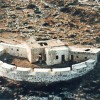
THE SANTA MARIJA BATTERY ON COMINO
This battery was proposed by the Grand Prior of France, Philippe de Vendôme to protect the south Comino channel in conjunction with the Marfa defences on Gozo and was erected in 1715 at the cost of 1018 scudi. It is one of the three surviving coastal batteries of Gozo and Comino. It had to be equipped with two iron 24-pounder and four iron 6-pounder guns. It also had 140 cannon balls weighing 24 pounds each and 280 weighing 6 pounds. However no powder was stored in it because it was not guarded and was far away from the St Mary’s Tower! It is mostly referred to by the locals as ‘It-Trunċiera’. A report prepared after a visit made by the Commander of Armaments in May 1722 stated that the battery was armed with four 9-pounder cannon but it was expected that another two 36-pounder guns had to be placed. A 1770 report states that the battery was armed with two 24-pounder guns and four 6-pounder guns. There was, however, no gunpowder, as the battery did not have a gunpowder magazine, and it was not even guarded. We know that most times the battery was abandoned but when an enemy assault was suspected, guards from the tower would go down to the battery. In 1833 Fr Felic Cutajar reported that there were 5 cannon in the battery.
During the nineteenth century a long room and a small outhouse were added, and an arch was opened in the landward wall to facilitate entrance. The gun-ports were indeed covered with the walls of the long room which changed completely the plan of the original battery. The ditch was also filled and the drawbridge removed.
Din l-Art Ħelwa Cleans And Restores The Site
The battery suffered extensive damage and was probably abandoned by as early as 1770. In 1996 Din l-Art Ħelwa decided to restore this historic site after the youth section of the time, under the leadership of Stanley Farrugia Randon, conducted various clean-ups. The Comino Hotel part-sponsored phase one of the restoration as well as offered considerable help especially regarding transport. The two 24-pounder barrels were still there from the period of the knights. Restoration at this point included work on the embrasures and the main entrance. In some places stones were crumbling as the original pointing had weathered away. Repair to a bulging wall of one of the rooms was urgently required and damage had also been caused by overgrowing vegetation, including a huge fig tree. The re-pointing of the entire enciente secured the structure. The entrance itself was in a critical condition and had to be repaired. In August 1997 a joint initiative between the Armed Forces of Malta and the Royal Navy airlifted a cannon from the nearby garrigue to its place. The cannon was spotted about 200 yards away and a helicopter was used to lift it out of its rocky pit and fly it to its place in a spectacular operation. The second phase of restoration started in the summer of 2002 and was conducted thanks to a sponsorship from P. Cutajar & Co Ltd. Baron Group conducted the work which included dismantling the bulging wall and rebuilding it using the same stones, as well as restoring the large room added by the British. Four gun carriages were also constructed for the four cannon. The Zammit Cutajar family had long established links with the island of Comino since 1926 when the island was leased to Turu Zammit Cutajar, who shortly after founded the Comino Farming Company with a view to promoting the sale of produce cultivated by people living there. Although the lease reverted back to the government in the sixties, the family connection remained as Mr Francis Cutajar continued to offer assistance to the dwindling population.
In 2003 urgent works were conducted on one of the rooms where an outer wall of one of the rooms was bulging outwards causing large cracks in the side walls and threatening the arch which supported the roof. This was caused by rainwater seeping in and washing away the soil infill between the thickness of the wall. The wall and roof were rebuilt. All the walls of the rooms of the battery were repointed on their interior and exterior. Work included placing an iron gate to the main entrance, blocking six of the eight embrasures with iron grills, and the mounting of the two extant cannon on proper carriages within the embrasures. Flagstones were laid in the two smaller rooms of the battery while the cement floor of the large room was patched. This emergency work completed the second phase of the restoration.
The third phase of restoration on the battery was conducted in the summer of 2004 and consisted of the roofing of the big room added by the British (room ‘D’ on plan). The roof had caved in and had to be reconstructed using the same methodology as the British did, namely corrugated iron and concrete.
Comino Battery still requires much work if it is to be completely restored and secured for the future. However Din l-Art Ħelwa needs funds for its completion. The Battery’s isolated location and accessibility remain a challenge for materials and employees to be engaged here. Its commanding view over the straits to Malta is spectacular.
Other minor structures may have been built on Comino to defend the islands from the inhabitants and at the same time to prevent it from becoming a base from where pirates would find it easy to attack Malta and Gozo. Such structures may have been built both before and after the period of the Knights (1530 to 1798). If one observes old maps of Comino more closely, one could observe that such structures existed but no trace of what they actually were exists.
The battery has been recently restored by European funds obtained by the Malta Tourism Authority.





Comments are closed.